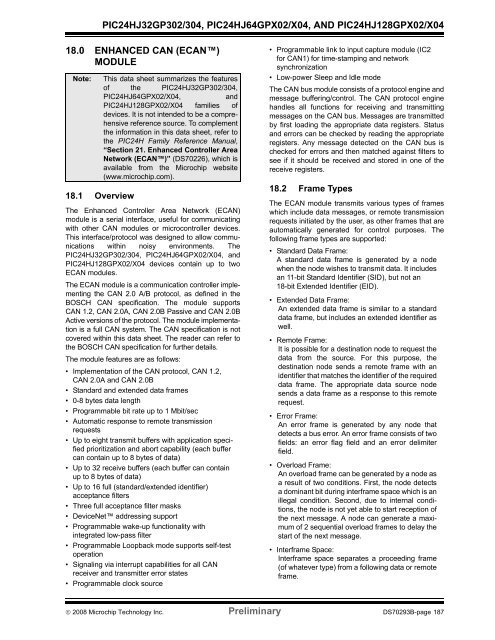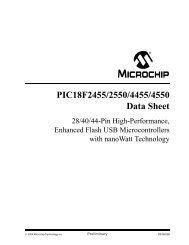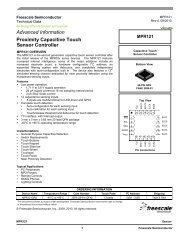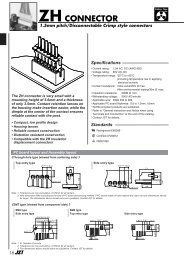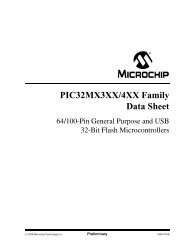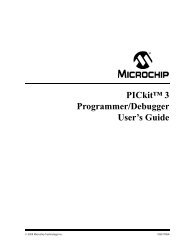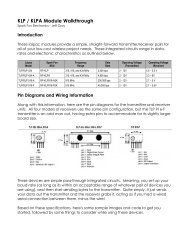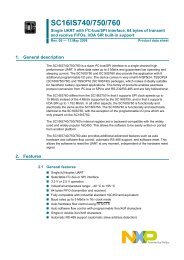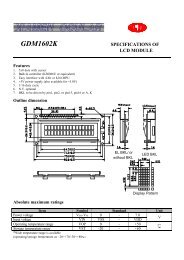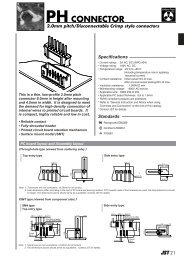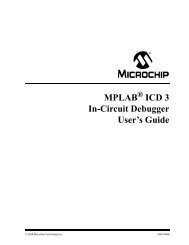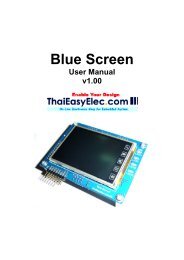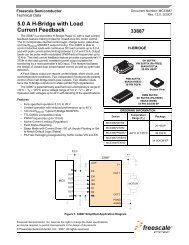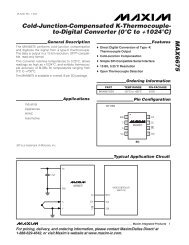PIC24HJ64 Datasheet
PIC24HJ64 Datasheet
PIC24HJ64 Datasheet
You also want an ePaper? Increase the reach of your titles
YUMPU automatically turns print PDFs into web optimized ePapers that Google loves.
PIC24HJ32GP302/304, <strong>PIC24HJ64</strong>GPX02/X04, AND PIC24HJ128GPX02/X04<br />
18.0 ENHANCED CAN (ECAN)<br />
MODULE<br />
Note:<br />
18.1 Overview<br />
This data sheet summarizes the features<br />
of the PIC24HJ32GP302/304,<br />
<strong>PIC24HJ64</strong>GPX02/X04,<br />
and<br />
PIC24HJ128GPX02/X04 families of<br />
devices. It is not intended to be a comprehensive<br />
reference source. To complement<br />
the information in this data sheet, refer to<br />
the PIC24H Family Reference Manual,<br />
“Section 21. Enhanced Controller Area<br />
Network (ECAN)” (DS70226), which is<br />
available from the Microchip website<br />
(www.microchip.com).<br />
The Enhanced Controller Area Network (ECAN)<br />
module is a serial interface, useful for communicating<br />
with other CAN modules or microcontroller devices.<br />
This interface/protocol was designed to allow communications<br />
within noisy environments. The<br />
PIC24HJ32GP302/304, <strong>PIC24HJ64</strong>GPX02/X04, and<br />
PIC24HJ128GPX02/X04 devices contain up to two<br />
ECAN modules.<br />
The ECAN module is a communication controller implementing<br />
the CAN 2.0 A/B protocol, as defined in the<br />
BOSCH CAN specification. The module supports<br />
CAN 1.2, CAN 2.0A, CAN 2.0B Passive and CAN 2.0B<br />
Active versions of the protocol. The module implementation<br />
is a full CAN system. The CAN specification is not<br />
covered within this data sheet. The reader can refer to<br />
the BOSCH CAN specification for further details.<br />
The module features are as follows:<br />
• Implementation of the CAN protocol, CAN 1.2,<br />
CAN 2.0A and CAN 2.0B<br />
• Standard and extended data frames<br />
• 0-8 bytes data length<br />
• Programmable bit rate up to 1 Mbit/sec<br />
• Automatic response to remote transmission<br />
requests<br />
• Up to eight transmit buffers with application specified<br />
prioritization and abort capability (each buffer<br />
can contain up to 8 bytes of data)<br />
• Up to 32 receive buffers (each buffer can contain<br />
up to 8 bytes of data)<br />
• Up to 16 full (standard/extended identifier)<br />
acceptance filters<br />
• Three full acceptance filter masks<br />
• DeviceNet addressing support<br />
• Programmable wake-up functionality with<br />
integrated low-pass filter<br />
• Programmable Loopback mode supports self-test<br />
operation<br />
• Signaling via interrupt capabilities for all CAN<br />
receiver and transmitter error states<br />
• Programmable clock source<br />
• Programmable link to input capture module (IC2<br />
for CAN1) for time-stamping and network<br />
synchronization<br />
• Low-power Sleep and Idle mode<br />
The CAN bus module consists of a protocol engine and<br />
message buffering/control. The CAN protocol engine<br />
handles all functions for receiving and transmitting<br />
messages on the CAN bus. Messages are transmitted<br />
by first loading the appropriate data registers. Status<br />
and errors can be checked by reading the appropriate<br />
registers. Any message detected on the CAN bus is<br />
checked for errors and then matched against filters to<br />
see if it should be received and stored in one of the<br />
receive registers.<br />
18.2 Frame Types<br />
The ECAN module transmits various types of frames<br />
which include data messages, or remote transmission<br />
requests initiated by the user, as other frames that are<br />
automatically generated for control purposes. The<br />
following frame types are supported:<br />
• Standard Data Frame:<br />
A standard data frame is generated by a node<br />
when the node wishes to transmit data. It includes<br />
an 11-bit Standard Identifier (SID), but not an<br />
18-bit Extended Identifier (EID).<br />
• Extended Data Frame:<br />
An extended data frame is similar to a standard<br />
data frame, but includes an extended identifier as<br />
well.<br />
• Remote Frame:<br />
It is possible for a destination node to request the<br />
data from the source. For this purpose, the<br />
destination node sends a remote frame with an<br />
identifier that matches the identifier of the required<br />
data frame. The appropriate data source node<br />
sends a data frame as a response to this remote<br />
request.<br />
• Error Frame:<br />
An error frame is generated by any node that<br />
detects a bus error. An error frame consists of two<br />
fields: an error flag field and an error delimiter<br />
field.<br />
• Overload Frame:<br />
An overload frame can be generated by a node as<br />
a result of two conditions. First, the node detects<br />
a dominant bit during interframe space which is an<br />
illegal condition. Second, due to internal conditions,<br />
the node is not yet able to start reception of<br />
the next message. A node can generate a maximum<br />
of 2 sequential overload frames to delay the<br />
start of the next message.<br />
• Interframe Space:<br />
Interframe space separates a proceeding frame<br />
(of whatever type) from a following data or remote<br />
frame.<br />
© 2008 Microchip Technology Inc. Preliminary DS70293B-page 187


